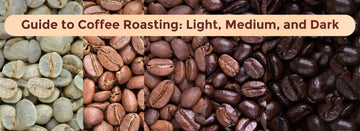Guide to Coffee Roasting: Light, Medium, and Dark
Coffee is much more than just a morning pick-me-up; it's a sensory experience that has the power to tantalize the taste buds, invigorate the mind and bring people together. Whether you're a coffee aficionado or a casual drinker, you may have wondered about the various shades of roasted coffees and what sets them apart.
Welcome to the ultimate Guide to Coffee Roasting: Light, Medium, and Dark with Sonnets by Tata Coffee. Here, you'll explore the fascinating world of coffee roasting and discover how the degree of roast can affect the flavor, aroma, and body of your coffee. From the delicate and floral notes of a light roast to the bold and smoky flavors of a dark roast, this guide will take you on a journey of sensory discovery.
So, grab a cup of your favorite brew, and let's dive into the art and science of coffee roasting!
1. Light Roast
Light roast coffee is often considered the purest expression of a coffee's origin and flavor profile. This roast level is achieved by roasting the beans for a relatively short period of time, typically between 7 to 10 minutes, at temperatures ranging from 350°F to 400°F.
What sets light roast coffee apart is its delicate and nuanced flavors. You'll often taste floral and fruity notes, with a bright acidity (lemon-like) that gives the coffee a refreshing and clean taste. The body of a light roast is typically lighter and less pronounced than other roast levels, allowing the unique flavors of the coffee beans to shine through.
Another benefit of light roast coffee is that it tends to contain relatively higher levels of caffeine than darker roasts as longer roasting may degrade the same. Light roast coffee is perfect for those who want to experience the unique flavors of a coffee's origin. It's also a great choice for those who prefer their coffee without the bitterness and smokiness that comes with darker roasts. If you're new to coffee, a light roast is a great cup to start as it allows you to explore the complex and subtle flavors of coffee without overwhelming your palate.
To get the most out of your light roast coffees, it's best to use a pour-over or drip coffee maker. This allows the delicate flavors to come through without being masked by the flavors of milk or cream. So, if you're looking for a coffee that's light, bright, and full of flavor, give light roast coffee a try. You might just discover a new favorite brew!
2. Medium Roast
Medium roast coffee strikes a balance between the delicate flavors of a light roast and the boldness of a dark roast. This roast level is achieved by roasting the beans for a slightly longer period of time than a light roast, typically between 10 to 12 minutes, at temperatures ranging from 410°F to 430°F.
What makes medium roast coffee unique is its well-balanced flavor profile. It has a slightly darker color and a fuller body than a light roast, with a flavor that's rich and complex. Medium roast coffee is often described as having notes of chocolate, caramel, and nuts, with a slightly lower acidity than a light roast. This makes it a popular choice for those who enjoy a smooth and easy-to-drink cup of coffee.
One of the benefits of medium roast coffee is its versatility. It can be enjoyed black or with a splash of milk, and it pairs well with a variety of foods, from sweet pastries to savory breakfast dishes.
Medium roast coffee is also a popular choice for espresso, as it's able to stand up to the intense pressure and heat of the brewing process without losing its flavor profile.
Overall, medium roast coffee is a great choice for those who want a coffee that's balanced and flavorful without being too bold or too delicate. It's the perfect choice for those who want to explore the rich and complex flavors of coffee while still enjoying a smooth and easy-to-drink cup. So, next time you're in the mood for a well-rounded coffee experience, give medium roast coffee a try. You might just discover your new favorite brew.
3. Dark Roast

Dark roast coffee is the polar opposite of light roast coffee. It's bold, intense, rich, smoky flavors. This roast level is achieved by roasting the beans for a longer period of time, typically between 12 to 15 minutes, at temperatures ranging from 435°F to 450°F.
What sets dark roast coffee apart is its intense taste and aroma. The longer roasting time caramelizes the sugars in the beans, resulting in a darker color and a rich, full-bodied flavor. Dark roast coffee is often described as having a bittersweet taste with notes of chocolate, caramel, and roasted nuts. It has low acidity and a heavy mouthfeel, making it a popular choice for those who prefer a bold and robust cup of coffee.
Dark roast coffee is also a popular choice for making espresso. The intense flavor and heavy body of dark roast coffee are able to stand up to the pressure and heat of the brewing process, resulting in strong and flavorful shots.
Dark roast coffee is a great choice for those who want a coffee that's bold, complex, and full of flavor. It's the perfect choice for those who enjoy a strong and robust cup of coffee in the morning or as an after-dinner treat. So, if you're in the mood for a coffee that packs a punch, give dark roast coffee a try. You might just discover a new favorite brew.
In conclusion, understanding the different roast levels of coffee is crucial for experiencing the diverse range of flavors and aromas coffee has to offer. From light to medium to dark roast, each roast level offers a unique taste and aroma profile. By experimenting with different roast levels and selecting high-quality beans, coffee lovers can experience the full potential of their daily cup of coffee.








